Social Care Services, Scotland, 2013
Information on Home Care Services, Self-Directed Support (Direct Payments), Community Alarms and Telecare, Meals services and Housing Support Services.
This document is part of a collection
3. Older People - Clients aged 65 and over
This section of the report shows more detail for Social Care clients aged 65 and over. It covers Home Care, Community Alarm/Telecare, Meals Services, Housing Support and Direct Payments.
3.1 Home Care for clients aged 65 and over
Figure 11 shows that the rate of clients aged 65 and over receiving Home Care has decreased steadily since 2004 to around 54 per 1,000 population.
Figure 11: Rates per population of Clients aged 65 and over receiving Home Care Services, 2000-2013
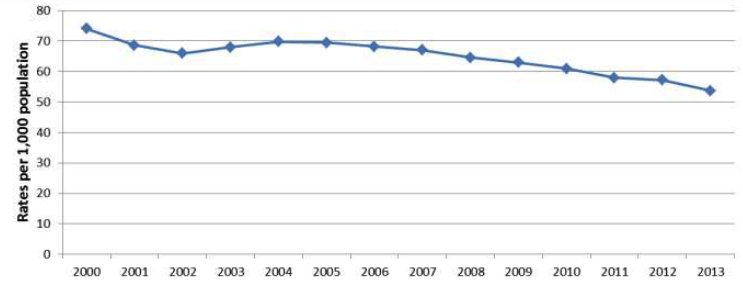
Source: Social Care Survey 2013, Home Care Census 2000-2012
General Register Office for Scotland mid-year populations up to 2012 (latest available).
Figure 12 shows the average number of Home Care hours per week for Home Care clients aged 65 and over. There has been a steady increase in the average weekly Home Care hours since 2000. For the new Social Care survey, local authorities were asked not to include clients receiving round the clock care (168 hours) as Home Care clients but rather as Housing support clients. This has resulted in a drop in the overall hours of care provided in 2013. However, removing everyone receiving 168 hours a week from the 2010- 2012 data shows that there has been a steady increase in average hours over the last four years. More information on this can be found in the background notes at the end of this publication.
Figure 12: Average hours per client per week, clients aged 65 and over, 2000 to 2013
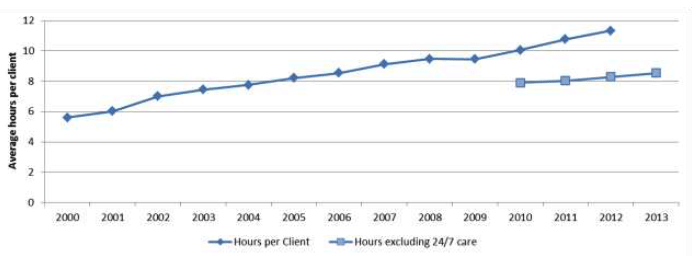
Source: Social Care Survey 2013, Home Care Census 2000-2012
Figure 13 shows that the majority of Home Care clients aged 65 and over receive care for less than 15 hours per week, and that the number of clients receiving more than 20 hours of care per week is relatively small.
Figure 13: Home Care clients aged 65 and over by level of service
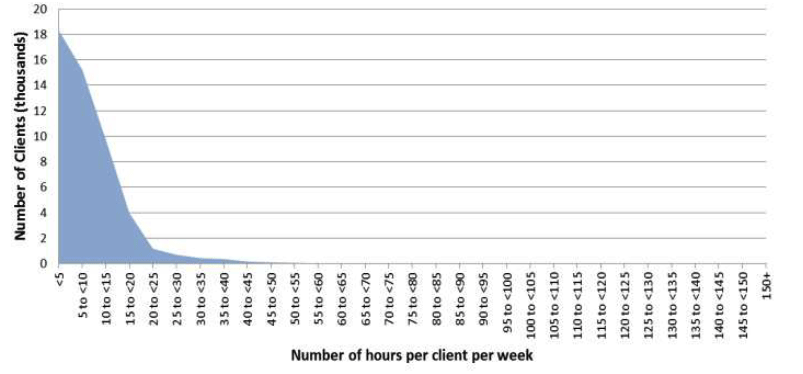
Source: Social Care Survey 2013
Table 1 shows that 60% of Home Care clients aged 65 and over receive their care solely from Local Authorities, compared with 31% receiving care solely from the private sector and 3% from the Voluntary sector. Clients who receive care solely from the Local Authority get on average 7.2 hours of Home Care per week while those receiving a service solely from the private sector get 9.9 hours per week and voluntary sector get 11.4 hours per week. Those receiving a service from multiple providers have on average even higher packages of care (between 12.1 and 16.6 hours per week on average).
Table 1: Number of Home Care clients aged 65 and over, and hours provided by Service Provider, 2013
| Provider of Service | Number of clients | % | Client Hours | % | Average hours per client |
|---|---|---|---|---|---|
| Local Authority only | 30,036 | 60% | 216,819 | 50% | 7.2 |
| Private sector only | 15,396 | 31% | 152,444 | 35% | 9.9 |
| Voluntary sector only | 1,328 | 3% | 15,202 | 4% | 11.4 |
| LA plus private | 2,566 | 5% | 36,168 | 8% | 14.1 |
| LA plus voluntary | 444 | 1% | 5,359 | 1% | 12.1 |
| All other combinations of 2+ providers | 245 | 0% | 4,079 | 1% | 16.6 |
| TOTAL | 50,354 | 100% | 430,071 | 100% | 8.5 |
Source: Social Care Survey 2013
Figure 14 shows the distribution of Home Care clients aged 65 and over in each client group, with a further age breakdown.
Figure 14: Home Care Clients aged 65 and over by Client group and age group
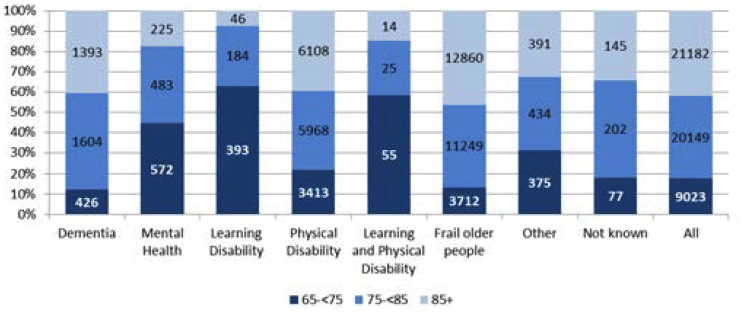
Source: Social Care Survey 2013
Note: "Dementia" is under recorded in the social care management information system.
Figure 15 shows that around two-thirds of Home Care clients aged 65 and over live alone.
Figure 15: Living arrangement of clients aged 65 and over receiving Home Care services, 2013
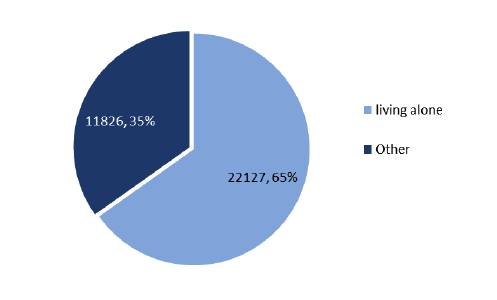
Source: Social Care Survey 2013
Note: Based on 33,953 clients. Information on living arrangement is unknown for 16,401 clients
3.2 Community Alarm / Telecare Services for clients aged 65 and over
From 2010 information was collected on clients who use services other than Home Care in their own home. These include Community Alarms and other Telecare services. Information on these services was collected for the first time in 2010, however a number of Local Authorities in 2010 were not able to provide information on all the clients in receipt of a Community Alarm and/or another Telecare Service. Since 2011, the completeness of this data has improved considerably. Trends over time therefore are presented from 2011 onwards. The Background Information provided in this report contains definitions of Community Alarm and 'other Telecare services.
As at the census week in March 2013, there were 96,920 people aged 65 and over receiving a Community Alarm and/or another Telecare Service. Of these 81% had only a Community Alarm and 15% had a Community alarm with additional telecare services.
Figure 16: Distribution of clients aged 65 and over receiving Community Alarm and/or another Telecare service, by client group, 2013
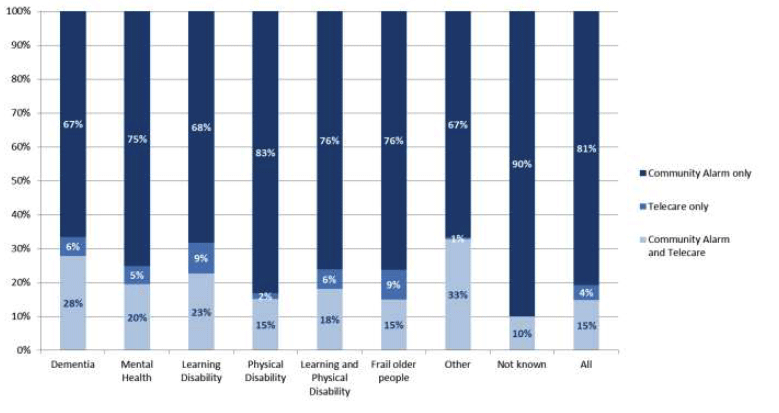
Source: Social Care Survey 2013
Note: "Other" includes addictions, palliative care and carers
Note: "Dementia" is under recorded in the social care management information system.
Figure 17 shows that the number of clients receiving Community Alarm and/or Telecare has increased each year since first collected in 2010: from 92,996 in 2011 to 96,920 in 2013.
Figure 17: Clients aged 65 and over receiving Community Alarm and/or other Telecare services, 2010 to 2013
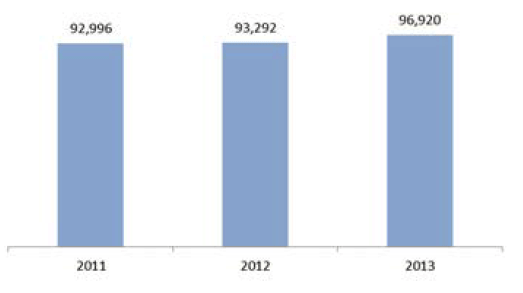
Source: Social Care Survey 2013, Home Care Census 2010-2012
3.3 Meals Services for clients aged 65 and over
The following table and chart contain information about Meal Services which clients can receive in their own home. Figure 18 shows that the majority of meals provided to clients aged 65 and over are hot meals. 14 Local Authorities provided only hot meals, 11 provided only frozen means, 4 provided both. 3 authorities did not provide meals data even if they do offer a meals service.
Figure 18: Clients aged 65 and over receiving Hot or Frozen Meals, by age, 2013
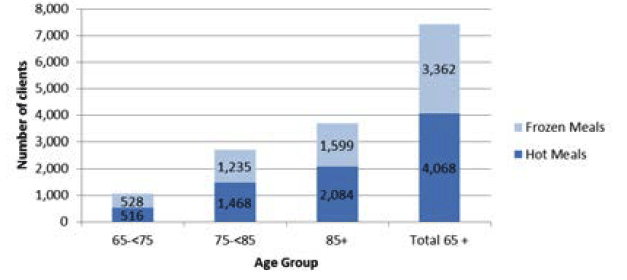
Source: Social Care Survey 2013
Note: 22 clients receive both hot and frozen meals
Figure 19 shows that the number of clients aged 65 and over receiving meals services has decreased from just under 10,000 in 2010 to under 8,000 in 2013.
Figure 19: Clients aged 65 and over receiving meals services, by age group, 2010 to 2013
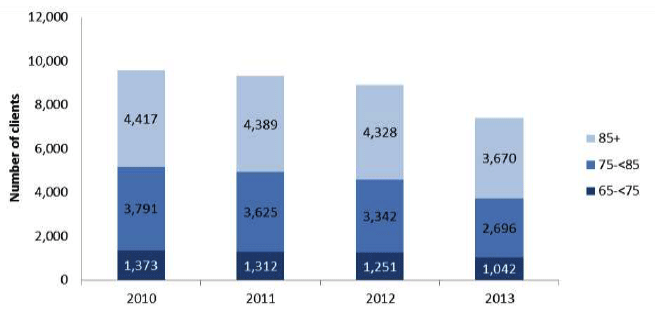
Source: Social Care Survey 2013, Home Care Census 2010-2012
Note: In 2010, only Scottish Borders were unable to provide data on meals
3.4 Housing Support for clients aged 65 and over
The Social Care Survey began collecting Housing Support services in 2013; previously this was an optional question in the Home Care survey. In 2013, over 10,000 clients aged 65 and over received Housing Support services. Figure 19 shows that the majority of these (64%) were female. 4 local authorities were unable to provide data on Housing Support even if they do offer this service.
Figure 20: Clients aged 65 and over who receive housing support, 2013
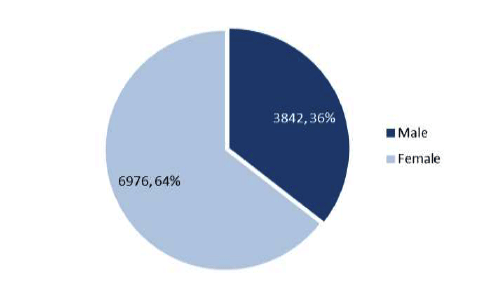
Source: Social Care Survey 2013
Note: Gender is unknown for one client
Figure 21 shows that physical disability and frailty due to old age are the primary reasons for clients aged 65 and over receiving Housing Support.
Figure 21: Clients aged 65 and over who receive Housing Support, by client group, 2013
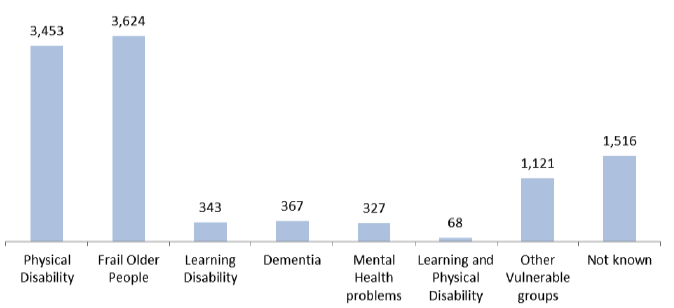
Source: Social Care Survey 2013
Note: "Dementia" is under recorded in the social care management information system.
3.5 Direct Payments for clients aged 65 and over
In the year ending 31 March 2013, 1,936 people aged 65 and over received direct payments. The total expenditure by local authorities on Direct Payments was £17 million.
Figure 22: Number of people aged 65 and over who received direct payments, 2001 to 2013
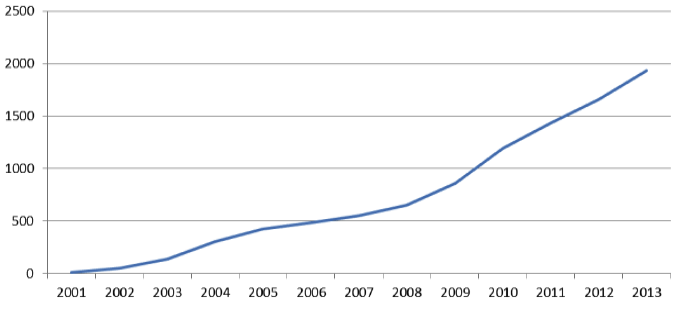
Source: Social Care Survey 2013, Self-directed Support(Direct Payments) Survey 2001-2012
Table 2 and Figure 23 show the breakdown of clients aged 65 and over receiving direct payments for each client group. While frailty due to old age is the primary reason for clients in this age group receiving Direct Payments, the average amount spent per client is highest for those with Learning Disabilities.
Table 2: Number of clients aged 65 and over, and value of Direct Payments, by client group, 2013
| Client Group | Number of clients | Expenditure (£ thousands) | Average £ per client |
|---|---|---|---|
| Dementia | 245 | £2,115 | £8,634 |
| Mental Health | 67 | £754 | £11,254 |
| Learning disability only | 28 | £614 | £21,932 |
| Learning disability and Physical disability | 5 | £85 | £17,061 |
| Physical disability only | 481 | £4,756 | £9,888 |
| Frail older people | 1,021 | £7,869 | £7,707 |
| Other | 54 | £514 | £9,512 |
| Not known | 35 | £383 | £10,938 |
| All | 1,936 | £17,091 | £8,828 |
Source: Social Care Survey 2013
Note: "Dementia" is under recorded in the social care management information system.
Figure 23: Average value of Direct Payments per client, by client group, for clients aged 65 and over, 2013
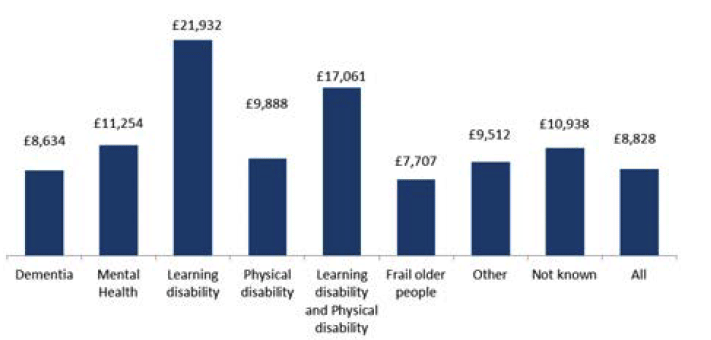
Source: Social Care Survey 2013
Note: "Dementia" is under recorded in the social care management information system.
Contact
Email: Steven Gillespie
There is a problem
Thanks for your feedback